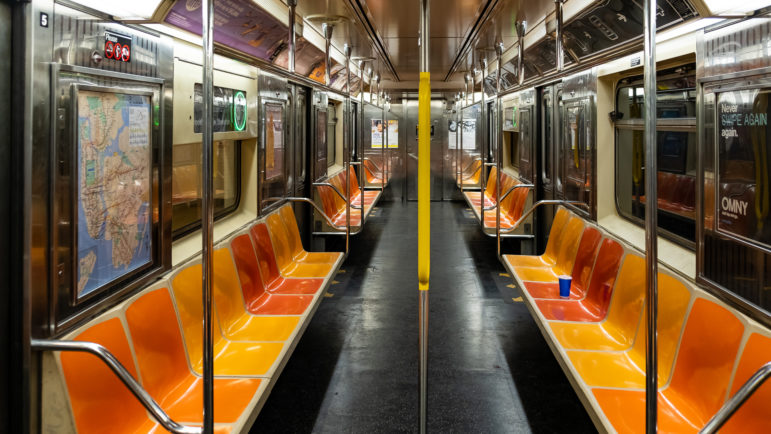
Adi Talwar
Empty car on a northbound 6 train as is departs from 59th around 5:30pm on March 18, 2020.The Coronavirus outbreak has brought much of public life in New York City to a halt, and it’s emptying its transit system. Ridership is down across the board: 60 percent on the subways, 49 percent on buses, 90 percent on Metro-North and 67 percent on Long Island Rail Road as of Tuesday. Commuters are tweeting videos of eerily vacant train cars at rush hour, and the cover of this week’s New Yorker features an illustrated Grand Central Terminal, empty except for a lone man sweeping.
Farebox revenue accounts for 38 percent of the MTA’s overall budget, and the ridership plummet is already having an impact on the transit agency’s finances, which were in bad shape before the health crisis. MTA Chairman Pat Foye asked federal lawmakers earlier this week for $4 billion in aid, which he says would offset revenue losses if current ridership trends continue for six months as well as cover the costs of continually sanitizing the system. Then on Friday, the MTA drew down $1 billion on its existing credit line for emergency funds.
“The ridership declines are huge, and given how much of the operations budget comes from the farebox…it’s huge,” says Nick Sifuentes, executive director for the Tri-State Transportation Campaign, one of several transit advocacy groups that penned a letter to New York’s federal lawmakers on Wednesday urging them to fulfill Foye’s request for aid.
On the national level, the American Public Transportation Association has asked the federal government to provide $16 billion in emergency funds to transit agencies across the country that are similarly struggling because of the pandemic, calling public transportation “a lifeline for essential services.”
“This is crucial to the economy of the region. Without affordable and reliable mass transit, New York doesn’t function the way it needs to,” says Rachael Fauss, of the good government group Reinvent Albany. She pointed to other industries, like airlines, which are seeking $50 billion in government aid to withstand the crisis.
“Mass transit is asking for a pittance compared to what they’re asking for,” she says. “No eyes should be batted at $4 billion.”
Just the beginning
That $4 billion may be a low estimate for what the MTA will ultimately need to weather the crisis it’s facing in COVID-19, experts say. It’s still uncertain how long the pandemic will last, and people may continue to avoid mass transit even after the worst of the outbreak is over.
“A lot of scientists are saying that this social distancing might last for a year, and that’s a huge blow to transit,” says Sifuentes.
The MTA’s money woes go beyond fewer riders and lost fares. The agency’s other sources of revenue—which includes funding from tolls, taxes, and state and local subsidies—are likely to be depleted by the economic downturn Coronavirus is expected to bring, as businesses shut down across the city and state and tourism grinds to a halt. A report from City Comptroller Scott Stringer’s office estimates the pandemic will cost the city $3.2 billion in lost tax revenues over the next six months alone. The state could face losses of between $4 to $7 billion, according to Comptroller Tom DiNapoli.
“It’s not just that farebox revenue is down. It’s toll revenue and it’s payroll tax revenue,” says Lisa Daglian, director at the Permanent Citizens Advisory Committee to the MTA (PCAC). “What we’re seeing now is the beginning of a really dire situation for the MTA.”
Advocacy groups are also urging the U.S. Department of Transportation to approve New York’s congestion pricing plan, which is awaiting federal permission to move forward. The plan, which would kick off in 2021 if approved and would charge people a fee to drive into Manhattan’s business district, is expected to generate $15 billion in MTA capital funding.
Keeping things moving
Even before the outbreak, the MTA was saddled with growing debt. The agency was already slated to slash 2,700 jobs by the end of the year, part of a “Transformation Plan” to reform the troubled agency—though the timing of that plan is being reconsidered in light of the pandemic, according to a report by THE CITY earlier this week.
“They’re already at bone,” says Fauss. “They’re already walking a tightrope with their budget because of their debt.”
Financial documents posted to the agency’s website on Wednesday, first reported on by Streetsblog, say the MTA has approximately $3.86 billion on hand it can use to temporarily offset COVID-19 losses, but notes that such funding will need to be “repaid or replaced,” or else it will “will likely result in additional debt issuance and unfunded operating needs.”
“If the observed ridership and traffic declines are sustained or deteriorate further, additional interventions will need to be considered by MTA, which may include, among other measures, temporary service adjustments,” the agency warns.
As of Friday, the MTA was running normal weekday service on its both subway and commuter rails, despite the large decline in ridership. While all weekday bus routes were running Friday, some were doing so at reduced levels because of the pandemic, according to an update on the MTA’s website.
“Our employees are taking the same precautions against spreading COVID-19 as everyone else, and this has impacted our staffing levels,” the update reads. As of Thursday, 23 MTA employees had tested positive for COVID-19, officials said.
Maintaining good service levels remains crucial, advocates say, since essential employees—like medical, grocery, sanitation and transit workers themselves—will still need to travel.
“Cutting transit right now would be basically saying to them, ‘We’re going to make your life harder than it already is,’” says Sifuentes. Regular service will also help keep trains and buses empty enough to allow those who do need to ride enough room for social distancing.
“If you want to space people out, then you have to maintain service frequencies.”
The COVID-19 pandemic could also potentially jeopardize “the timing of MTA initiatives to improve its systems,” according to the agency’s financial disclosure statement. The MTA’s current capital plan, approved last year, is the largest in its history at $51.5 billion. It includes projects like the next phase of the Second Avenue Subway, making dozens of new stations ADA-accessible and upgrading subway signal systems on multiple lines—all efforts to modernize the and turn the struggling system around.
Those improvements, particularly the signal upgrades, remain especially important in light of the operating losses the MTA is facing from coronavirus, advocates say. “That is crucial core work that has to be done,” says Fauss.
She and others say much of the MTA’s financial fate is now dependent on securing federal aid.
“The whole thing, everything, is pending on the actions of the federal government,” Sfuentes says.










